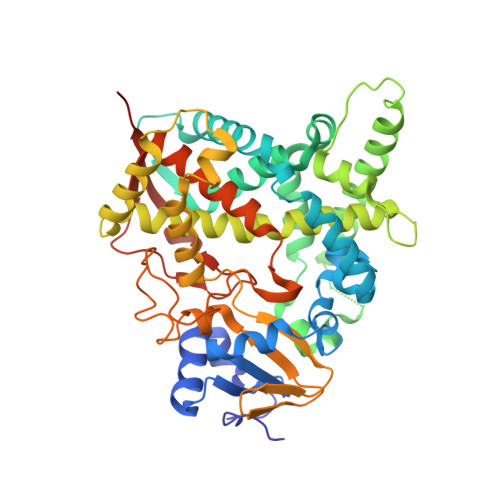Clinical Candidate Vt-1161'S Antiparasitic Effect in Vitro, Activity in a Murine Model of Chagas Disease, and Structural Characterization in Complex with the Target Enzyme Cyp51 from Trypanosoma Cruzi.
Hoekstra, W.J., Hargrove, T.Y., Wawrzak, Z., Da Gama Jaen Batista, D., Da Silva, C.F., Nefertiti, A.S.G., Rachakonda, G., Schotzinger, R.J., Villalta, F., Soeiro, M.D.N.C., Lepesheva, G.I.(2015) Antimicrob Agents Chemother 60: 1058
- PubMed: 26643331
- DOI: https://doi.org/10.1128/AAC.02287-15
- Primary Citation of Related Structures:
5AJR - PubMed Abstract:
A novel antifungal drug candidate, the 1-tetrazole-based agent VT-1161 [(R)-2-(2,4-difluorophenyl)-1,1-difluoro-3-(1H-tetrazol-1-yl)-1-{5-[4-(2,2,2-trifluoroethoxy)phenyl]pyridin-2-yl}propan-2-ol], which is currently in two phase 2b antifungal clinical trials, was found to be a tight-binding ligand (apparent dissociation constant [Kd], 24 nM) and a potent inhibitor of cytochrome P450 sterol 14α-demethylase (CYP51) from the protozoan pathogen Trypanosoma cruzi. Moreover, VT-1161 revealed a high level of antiparasitic activity against amastigotes of the Tulahuen strain of T. cruzi in cellular experiments (50% effective concentration, 2.5 nM) and was active in vivo, causing >99.8% suppression of peak parasitemia in a mouse model of infection with the naturally drug-resistant Y strain of the parasite. The data strongly support the potential utility of VT-1161 in the treatment of Chagas disease. The structural characterization of T. cruzi CYP51 in complex with VT-1161 provides insights into the molecular basis for the compound's inhibitory potency and paves the way for the further rational development of this novel, tetrazole-based inhibitory chemotype both for antiprotozoan chemotherapy and for antifungal chemotherapy.
Organizational Affiliation:
Viamet Pharmaceuticals, Inc., Durham, North Carolina, USA.
















